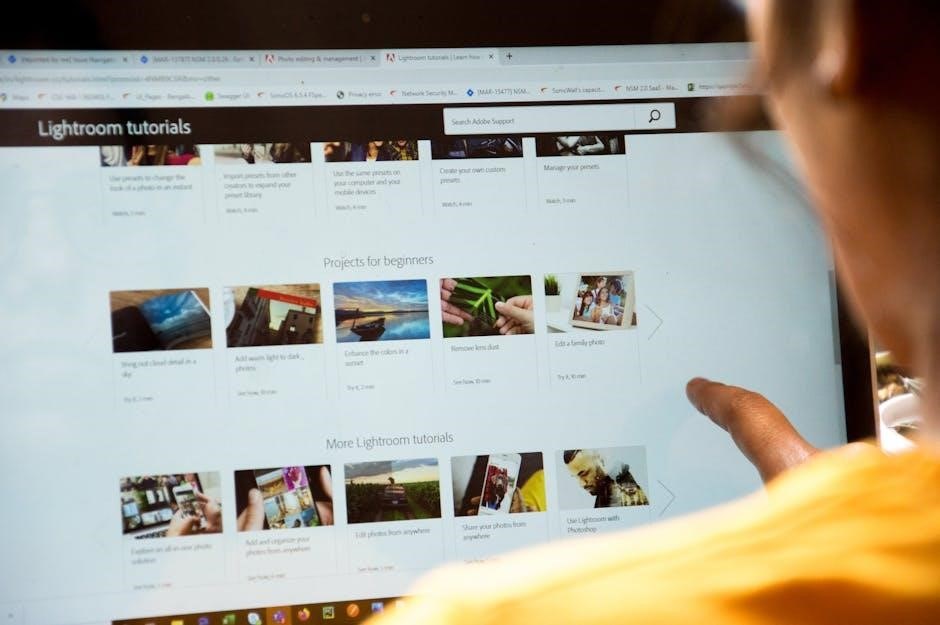The Marzano Instructional Framework, developed by Dr. Robert Marzano, is a research-based model designed to enhance teacher effectiveness and student learning outcomes through proven strategies and practices.
Overview of the Framework and Its Importance
The Marzano Instructional Framework is a research-based model designed to enhance teaching effectiveness and student learning. It provides educators with a structured approach to instruction, emphasizing evidence-based strategies. By focusing on four key domains—classroom strategies, planning, reflection, and professional responsibilities—it offers a comprehensive system for improving educational outcomes. The framework’s importance lies in its ability to align teaching practices with proven methods, fostering a culture of continuous improvement and collaboration among educators.
History and Development of the Marzano Framework
Dr. Robert Marzano developed this framework over 50 years, drawing from extensive education research. It began with his work at Mid-continent Research for Education and Learning (McREL), identifying effective instructional strategies. The framework evolved through numerous studies and publications, culminating in “The New Art and Science of Teaching” in 2017. This comprehensive model has become a cornerstone for teacher evaluation and professional development, widely adopted to enhance teaching practices and student achievement across diverse educational settings.
Key Principles and Domains of the Framework
The Marzano Framework is built on research-based principles that emphasize effective teaching practices and student learning. It is organized into four domains: Classroom Strategies and Behaviors, Preparing and Planning, Reflecting on Teaching, and Professional Responsibilities. These domains are further divided into 23 elements, providing a structured approach to teacher evaluation and professional development. The framework focuses on creating a common language for instructional excellence, ensuring alignment between teacher actions and student outcomes.
The Four Domains of the Marzano Instructional Framework
The Marzano Framework comprises four domains: Classroom Strategies, Planning, Reflecting on Teaching, and Professional Responsibilities, providing a structured approach to enhance teaching effectiveness and improve student learning outcomes.
Domain 1: Classroom Strategies and Behaviors
Domain 1 focuses on classroom strategies and teacher behaviors that promote active student engagement and effective learning. It includes techniques like encouraging participation, using non-verbal cues, and organizing the classroom environment. These strategies ensure a structured and focused learning atmosphere, fostering higher levels of student engagement and academic success. By implementing these practices, teachers can create a positive and productive classroom culture that supports diverse learning needs and enhances overall student outcomes.
Domain 2: Preparing and Planning
Domain 2 emphasizes the importance of thorough lesson preparation and planning to ensure effective instruction; It involves setting clear learning goals, aligning content with standards, and selecting appropriate instructional materials. Teachers are encouraged to design engaging lessons that cater to diverse student needs and incorporate research-based strategies. Effective planning ensures that instruction is focused, coherent, and aligned with desired outcomes, ultimately enhancing teaching quality and student learning experiences across all content areas.
Domain 3: Reflecting on Teaching
Domain 3 focuses on the reflective practices teachers use to evaluate and improve their instructional effectiveness. This involves analyzing teaching strategies, assessing their impact on student learning, and making data-driven adjustments. Reflective practices also include seeking feedback from peers and students, as well as engaging in professional development to stay updated on best practices. Continuous reflection fosters a growth mindset, enabling teachers to refine their methods and enhance student outcomes consistently over time.
Domain 4: Professional Responsibilities
Domain 4 emphasizes teachers’ professional responsibilities beyond the classroom, including collaboration with colleagues, participation in professional development, and communication with parents. This domain highlights the importance of contributing to a positive school culture, adhering to ethical standards, and advocating for student success. By fulfilling these responsibilities, educators support the broader educational mission and foster a collaborative environment that benefits both students and the school community. This domain underscores the teacher’s role as a professional and a team member.

Marzano’s Nine Instructional Strategies
Marzano’s nine instructional strategies are evidence-based techniques proven to enhance student performance. They include identifying similarities, summarizing, self-questioning, cooperative learning, goal-setting, and metacognitive approaches to improve learning outcomes effectively.
Strategy 1: Identifying Similarities and Differences
Identifying similarities and differences is a cornerstone strategy in Marzano’s framework. By comparing concepts, students enhance understanding and retention. Techniques like Venn diagrams and Voki help visual learners grasp relationships while fostering critical thinking. This strategy applies across subjects, from science to literature, ensuring deep comprehension. It also encourages collaborative discussions, where students can articulate their thoughts and gain insights from peers, enriching the learning experience and promoting engagement in the classroom environment effectively always.
Strategy 2: Summarizing and Note-Taking
Summarizing and note-taking are essential skills that enhance learning outcomes by helping students organize and retain information. These practices encourage active engagement and deeper understanding of content. Techniques like Cornell note-taking and summarization exercises allow students to distill key ideas, making complex concepts more manageable. This strategy also supports formative assessment, enabling teachers to gauge student comprehension and adjust instruction effectively, ensuring alignment with learning goals and promoting academic success across all subject areas consistently.
Strategy 3: Self-Questioning
Self-questioning is a metacognitive strategy that enhances critical thinking and comprehension. Students learn to ask themselves questions to clarify and organize information, fostering deeper understanding. This approach encourages active engagement with content, helping students identify knowledge gaps and monitor their learning progress. Teachers can model self-questioning techniques, such as posing open-ended questions, to guide students in developing this skill. Regular practice of self-questioning improves problem-solving abilities and promotes independent learning, making it a valuable tool for academic success across subjects and grade levels.
Strategy 4: Cooperative Learning
Cooperative learning is a strategy that promotes active engagement by organizing students into small groups to work toward common goals. Structured activities encourage collaboration, teamwork, and communication. Teachers assign roles and ensure accountability, fostering social skills and academic success. This approach enhances critical thinking and problem-solving while building interpersonal relationships. By leveraging group dynamics, cooperative learning creates a supportive environment where students learn from one another, promoting deeper understanding and shared responsibility for outcomes.
Strategy 5: Setting Goals and Providing Feedback
Setting goals and providing feedback is a powerful strategy that guides students toward specific learning objectives. Teachers establish clear, measurable goals aligned with standards, ensuring students understand expectations. Regular, constructive feedback helps students track progress, identify strengths, and address areas for improvement. This strategy fosters self-awareness, motivation, and a growth mindset, enabling students to take ownership of their learning. By linking goals with targeted feedback, teachers create a structured pathway for continuous improvement and academic success.
Strategy 6: Metacognitive Strategies
Metacognitive strategies involve teaching students to reflect on and regulate their own thinking and learning processes. By fostering self-awareness, students can better understand how they process information, identify areas for improvement, and develop problem-solving skills. These strategies encourage active thinking, self-monitoring, and self-regulation, enabling learners to take greater control of their academic success. Implementing metacognitive practices helps students become more independent and effective learners, enhancing their ability to apply knowledge across various contexts and subjects.
Strategy 7: Teaching Vocabulary
Teaching vocabulary effectively is crucial for student comprehension and academic success. Marzano’s framework emphasizes explicit instruction, where teachers directly teach high-utility words and their meanings. This includes providing clear definitions, examples, and opportunities for practice. Additionally, encouraging active engagement through discussions, writing, and multimedia tools helps reinforce vocabulary retention. By systematically integrating vocabulary instruction, educators ensure students build a robust lexicon, which in turn enhances their ability to understand complex texts and communicate effectively in all subject areas.
Strategy 8: Generating and Testing Hypotheses
Generating and testing hypotheses is a powerful instructional strategy that fosters critical thinking and scientific inquiry. Students are guided to formulate educated guesses based on prior knowledge and evidence. They then test these hypotheses through structured experiments or analysis. This approach promotes active learning, problem-solving, and conceptual understanding. Teachers provide feedback and encourage reflection on the process and outcomes, helping students refine their thinking and deepen their engagement with the subject matter.
Strategy 9: Classroom Management
Classroom management is crucial for creating a productive learning environment. This strategy emphasizes establishing clear expectations, routines, and procedures to minimize disruptions. Teachers use proactive approaches to encourage positive student behavior and address misbehavior effectively. By fostering a respectful and orderly classroom, educators can maximize instructional time and ensure students stay focused on academic goals. Effective management also promotes a sense of safety and inclusivity, enabling students to thrive academically and socially.

Assessment and Progress Monitoring in the Framework
The Marzano Framework emphasizes formative assessments to track student progress, using data to inform instruction and guide teaching strategies. This approach ensures continuous improvement and personalized learning.
Formative Assessment Strategies
Formative assessments in the Marzano Framework involve ongoing evaluations to monitor student progress and understanding. These strategies include frequent checks, quizzes, and discussions to identify learning gaps. Teachers use this data to adjust instruction, ensuring personalized learning experiences. This approach fosters a growth mindset, enabling students to track their development and take ownership of their learning. Regular feedback loops between teachers and students are crucial, promoting targeted interventions and enhancing overall academic outcomes effectively.

Tracking Student Progress
Tracking student progress within the Marzano Framework involves systematic monitoring of learner advancements toward specific goals. Teachers utilize tools like progress tracking sheets, digital platforms, and portfolios to document growth. Regular updates allow educators to identify strengths and areas needing improvement, enabling timely interventions. Students also engage in self-monitoring, fostering accountability and self-awareness. This continuous process ensures personalized learning paths and aligns instruction with individual student needs, ultimately driving academic success and fostering a culture of continuous improvement and growth; Accurate tracking supports informed decision-making for educators and learners alike.
Using Data to Inform Instruction
Using data to inform instruction is a cornerstone of the Marzano Framework, enabling educators to make informed decisions that enhance student learning. By analyzing formative and summative assessment results, teachers identify learning gaps and adjust instructional strategies accordingly. Data-driven insights help tailor lessons to meet individual needs, ensuring personalized learning experiences. This approach fosters a culture of continuous improvement, where teaching methods evolve based on evidence of student progress, ultimately leading to improved academic outcomes and more effective teaching practices.

Professional Development and Implementation
The Marzano Framework emphasizes ongoing professional development for educators, providing structured training and support to enhance teaching skills and promote collaborative learning environments effectively.
Teacher Training and Support
Teacher training within the Marzano Framework focuses on enhancing instructional skills through evidence-based practices and resources. Educators engage in structured programs, including workshops and coaching, to master the framework’s strategies. The Marzano Compendium of Instructional Strategies provides supplementary materials to support professional growth. Schools often implement collaborative learning environments, fostering peer support and shared expertise. This approach ensures teachers are well-equipped to implement the framework effectively, bridging the gap between theory and classroom practice to improve student outcomes and teaching quality.
Building a Culture of Collaboration
The Marzano Framework emphasizes fostering collaboration among educators to enhance instructional practices. By creating a shared language and common goals, schools cultivate a culture where teachers work together to refine strategies and address challenges. Professional development opportunities, collaborative planning sessions, and peer feedback mechanisms encourage trust and shared responsibility. This collective approach ensures educators are aligned in their efforts to improve teaching and student learning, creating a cohesive and supportive educational environment.
Evaluating Effectiveness of the Framework
Evaluating the Marzano Framework’s effectiveness involves assessing its impact on teaching practices and student outcomes. The Focused Evaluation Model supports standards-based instruction, while formative assessments and progress tracking provide data to refine strategies. By analyzing student performance and instructional practices, educators can determine the framework’s success in improving learning. Continuous monitoring ensures the framework adapts to emerging educational needs, maintaining its relevance and effectiveness in fostering academic excellence and teacher growth.
The Marzano Framework, rooted in 50 years of research, continues to evolve, offering adaptable strategies for modern education, fostering collaboration and innovation in teaching and learning.
Impact of the Marzano Framework on Education
The Marzano Framework has significantly transformed education by providing a research-based approach to teaching and learning. Its emphasis on proven instructional strategies has improved student achievement across various content areas and grade levels. By offering a common language for educators, the framework fosters collaboration and aligns instructional practices with student needs. The integration of formative assessments and reflective teaching practices has further enhanced its effectiveness, making it a cornerstone of modern educational reform and a tool for fostering academic excellence.
Future Trends and Innovations
The Marzano Framework is poised to integrate emerging technologies, such as AI-driven tools, to enhance instructional strategies and personalize learning experiences. Innovations in data analytics will enable educators to track student progress more effectively, while micro-learning units will offer concise, accessible professional development opportunities. The framework may also expand to incorporate more metacognitive practices, fostering deeper student engagement and critical thinking. These advancements aim to ensure the framework remains a cutting-edge model for educational excellence in a rapidly evolving world.
